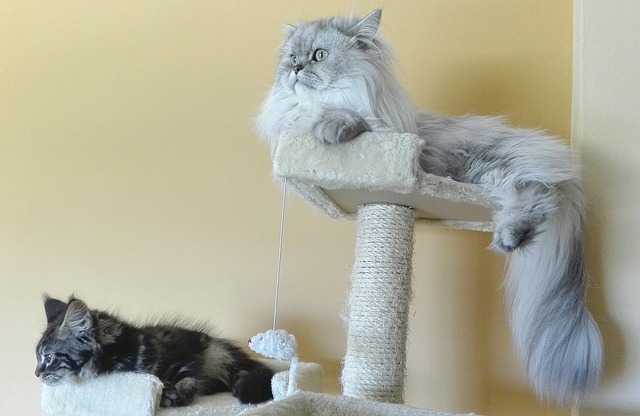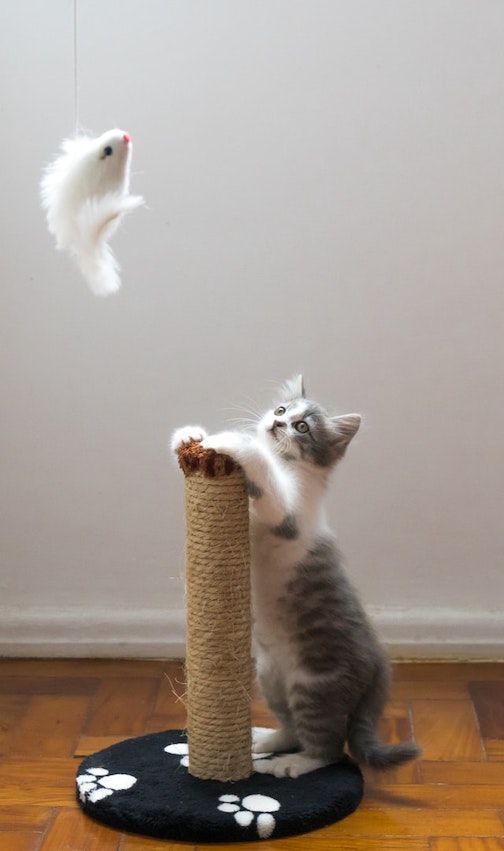How to Determine Your Cat’s Scratching Style
Posted: 11/06/2023 | BY: Erin Cain | Categories: Cat , Uncategorized
As a cat parent, you know your feline best. You know every habit, quirk, like and dislike that your cat has or develops. Like most cat parents, you have given your cat multiple scratching posts, pads, boxes, and probably a cat tree or two. So what has gone wrong when you bring home a perfectly new scratcher with added catnip, and your cat barely acknowledges its existence? Scratching is instinctive for felines and involves their need to mark their territory, leaving behind their mark and scent through scratching. However, not all cats enjoy the same scratching surfaces. How much do you know about your cat’s scratching preferences? Here’s how to select the right scratching surface for your cat so you’ll never have an unused scratcher again.

Why does scratching happen?
Cats scratch surfaces because it is an instinctual behavior, one that has carried through millennia from their feline ancestors to our domesticated cats today. Ancient feline relatives scratched trees to mark territory and to intimidate potential predators. That action deposits pheromones onto the tree these early felines marked. Your cat also has this ability, thanks to the interdigital glands in her paws. These glands leave behind your cat’s scent after she has scratched a surface in your home. Once that scent begins to fade, your cat will return and repeatedly mark that same spot. That’s why your cat will continue to scratch the same areas on your furniture.
Domesticated cats may mark their territory to feel safe and secure, but there are other important reasons for their need to scratch. Cats scratch to keep their claws conditioned and to file down the outer layers of the nails. Research also suggests that cats who scratch immediately after standing up may do so to stretch their bodies and strengthen their muscles. Scratching is also an excellent way for cats to relieve boredom and stress.

What’s your cat’s scratching style?
Not all cats are created equal, as any cat parent with more than one kitty in their lives is well aware of. This adage also applies to a cat’s scratching style. There are a wide variety of scratchers available. Before you spend money on an expensive item only to see your cat studiously ignore it, you want to determine your cat’s scratching style.
Vertical scratchers
Do you notice that your cat prefers to scratch the sides of your couch or sofa? Or does she enjoy scratching doorways or doorposts? If so, your cat is a vertical scratcher and will most likely want an upright post, condo, or tree. Make sure you pick a vertical scratcher that is long and tall enough for your cat to stretch her muscles while scratching.
Horizontal scratchers
If you’ve ever seen your cat scratching your carpet, rug, or floor mat, you most likely have a horizontal scratcher on your hands. Horizontal scratchers typically enjoy flat or curved box scratchers as a way to release energy and mark their territory. Consider purchasing reversible horizontal scratchers or ones that offer different types of surfaces or catnip to add some extra zest to your cat’s exercise.
Incline and uniquely shaped scratchers
Some cats are less picky about their scratching surfaces and like uniquely shaped or incline scratchers. Bed-type scratchers or cube scratchers have vertical and horizontal sides, so they provide the best of both worlds for cats. Often, these multi-surface scratchers have attached toys to evoke your cat’s hunting instincts as well.
Texture and stability: core scratcher components
Perhaps your cat doesn’t fall into any of the above classifications, and instead of style, your cat is more about texture. To effectively scratch, a cat needs rougher material she can dig her nails into. The top texture choice for scratchers is woven sisal, a sustainable material that is extremely durable. The durability of woven sisal means that your cat will get more long-term use from her scratcher because sisal material won’t come apart or shred.
Other materials that may appeal to your cat include seagrass, corrugated cardboard, wood scratchers, and carpeted scratchers. Try a few different textures to see which ones your cat enjoys the most.
Don’t forget that stability is key to any scratcher, especially condos, posts, and trees. Your cat will want to scratch hard, so be sure you pick a scratcher that can withstand heavy use and won’t fall over.
Figure out your cat’s style for a happy, healthy kitty.
Our cats are spoiled, but they deserve it. Keep your kitty happy and healthy by determining your cat’s scratching style and supplying her with scratchers that will satisfy her instincts and needs.
Continue to keep your cat healthy with a pet insurance policy. Get a free quote from Pet Insurance Review today.
References:
- Alley Cat Allies. (2021). Cat Behavior: Scratching. Retrieved by https://www.alleycat.org/community-cat-care/cat-behavior-scratching/
- Cat Care Center of Baton Rouge. (2021). Felines, Pheromones, and Claws. Retrieved from https://www.catcarecenter.com/services/cats/blog/felines-pheromones-and-claws
- Estep, D., Hetts, S. (1994). Why Cats Scratch. Retrieved from https://www.oahs.org/pdf/Behavior/Cat/Declawing/Whyscratch.pdf
- Purrfect Post. (2021). Sisal Fabric: The Best Material for Cat Scratching Posts. Retrieved from https://www.purrfectpost.com/sisal-fabric-the-best-material-for-cat-scratching-posts/
Disclaimer
The information contained on this blog is intended for informational and educational purposes only and should not be construed as medical advice. It is not a substitute for professional veterinary care. Always consult with your veterinarian before making any changes to your pet's health care or treatment plan.
The authors of this blog are not veterinarians and do not claim to be experts in pet health. The information provided here is based on our own experiences and research, as well as information from reputable sources. However, we cannot guarantee the accuracy or completeness of this information.
We encourage you to do your own research and consult with your veterinarian before making any decisions about your pet's health.
Previous post
CBD Oil for Pets: Hype or Helpful?Next post
How to Treat Insect Bites on Your PetCompare top pet insurance providers plans.
Enter your dog’s age in years and months to calculate their age equivalent to human years.
Calculate your dog’s ageEnter your cat’s age in years and months to calculate their age equivalent to human years.
Calculate your cat’s age